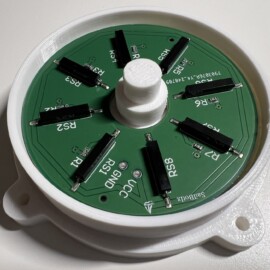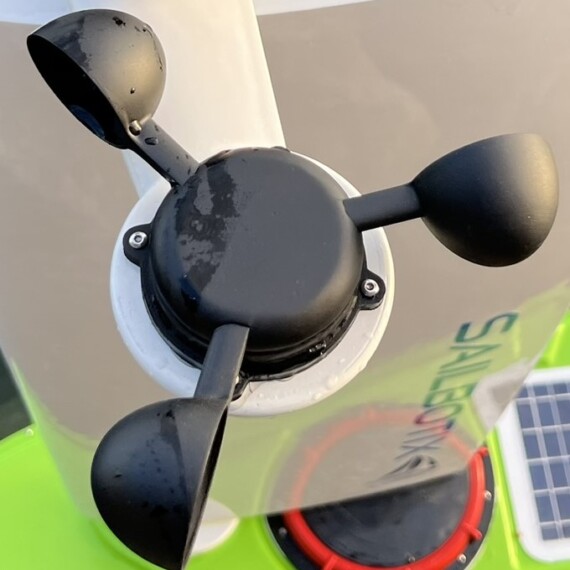Our boats can be outfitted with a multitude of different sensors. Basic operating sensors are included with the vessels, while environmental monitoring sensors are optional. Currently, we have over ten sensors available, and the number continues to grow. Most of our sensors utilize I2C communication protocols, though we also support digital and analog inputs. Sensors come pre-installed in the boat and are operational as soon as the boat is turned on.
Both the Silicon Sailor and Hybrid Voyager models, which use Iridium SBD communications, can transmit data in real-time and support all our sensors. The Wind Wanderer model cannot transmit sensor data but can be equipped with optional data logging sensor packages. Data can then be downloaded when the boat is physically retrieved.
When purchasing a boat, you can select the additional sensors from our online store, which will be installed at our facility before shipping. Some sensors require a masthead sensor bar (sold separately) as they need to be positioned high and in open air.

Available Sensors
.
We have designed our anemometer inhouse to be lightweight, strong and power efficient. A mechanical style was chosen instead of ultrasonic because it is much more power efficient. The anemometer has been carefully calibrated with the software translating RPM to windspeed. The bearings used are chemically inert, therefore are impervious to salt water, providing years of smooth action.
 Our windvane is also designed and manufactured inhouse in order to have the lightest most power efficient unit possible. The windvane determines wind direction relative to the boat, while the primary processor compares this with the boat’s direction of heading (using the compass) to translate it to actual wind direction in degrees relative to true north.
Our windvane is also designed and manufactured inhouse in order to have the lightest most power efficient unit possible. The windvane determines wind direction relative to the boat, while the primary processor compares this with the boat’s direction of heading (using the compass) to translate it to actual wind direction in degrees relative to true north.
Our air temperature thermometer is housed in the masthead sensor bar where it is not influenced by waves and spray. The thermometer operates using a thermistor, a resistive element whose resistance changes with temperature. This change in resistance is measured and converted into a digital signal by an Analog-to-Digital Converter (ADC) within the sensor. Calibration data and compensation algorithms are then applied to produce accurate temperature readings in degrees Celsius, which are output via I2C interface.
This was an especially challenging sensor for us to develop. The barometric pressure sensor cannot be housed inside the boat or within a sealed (or potted) container, as it would not be able to measure external changes in barometric pressure. On the other hand, if the sensor is placed outside the vessel, it would quickly be destroyed by the salt water. Instead, as part of the masthead sensor mount, we have created a chamber that allows air to pass through a Gore-tex membrane, enabling internal pressure to fluctuate in sync with external air pressure while keeping moisture out.
The pressure sensor works using a piezo-resistive element that changes its electrical resistance in response to pressure applied to a flexible diaphragm. When air pressure changes, it causes the diaphragm to deform, altering the resistance of the piezo-resistive element. This resistance change is measured and converted into a digital signal by an internal Analog-to-Digital Converter (ADC). The sensor applies calibration data and compensation algorithms to these raw readings, producing accurate pressure measurements which are then output via I2C.
The CO2 sensor is housed in clear air on the masthead sensor mount. A permeable membrane allows air exchange while keeping moisture out. It is a true CO2 sensor utilizing photoacoustic technology to measure CO2 levels accurately. It offers a wide measurement range of 400 to 5000 ppm with an accuracy of ±(40 ppm + 5% of reading) and includes onboard voltage regulation to minimize noise. This sensor is ideal for environmental monitoring, air quality studies, and scientific experiments.
Our light sensor is housed in the masthead sensor bar, ensuring readings aren’t distorted by shading from the sail. With an unobstructed view of the sky, it can precisely measure ambient light levels. This data can determine solar availability for future projects by gathering solar data in the area. It provides weather insights, such as whether it’s cloudy or sunny, and can trigger other sensors, like turning on a light when it gets dark.
Our light sensor measures ambient light in lux, featuring a 16-bit dynamic range from 0 to 120,000 lux, adjustable gain, and integration times. It interfaces via I2C.
A special thru-hull water temperature sensor is externally mounted on the hull to provide accurate measurements on water temperature. It is low drag, and interfaces with our system using I2C.
Our proprietary wave height sensor provides wave height, period and direction using inputs from an accelerometer, gyroscope and magnetometer.
Your boat isn’t likely to leak, but if it does, this sensor will provide valuable insights. The sensor not only detects the presence of water but also measures its depth. While there are many methods to measure water depth, we believe this system is the most elegant. It is a solid-state solution using a series of capacitance sensors arranged vertically. Unlike conductivity sensors that are prone to corrosion, our capacitance sensors are fully sealed and impervious to salt water.
The capacitance sensors are housed in a container designed to handle the sloshing that creates variable depths, providing measurements close to what they would be if the vessel were stationary and upright.
Our AIS receiver receives AIS data transmitted from ships within a 20-40 km radius, and relays key information via the Iridium communications. This sensor requires our masthead sensor mount for installation. Please note, this is just a receiver and not a transmitter, so it will not broadcast it’s own AIS information.
Our cameras are still in development and won’t be ready for sale until the Starlink Sat to Cell service becomes available. The limiting factor isn’t the installation of the cameras, but the communications bandwidth.
We have exciting plans for our AI-based camera monitoring system. We intend to run advanced AI on NVIDIA processor companion computers. These computers will cycle on and off, processing camera feeds, acoustic data, and AIS information. They will forward snippets of any anomalies or unusual occurrences to the shore operator.
Our hydrophones are still in development. We can’t tow a large hydrophone array, however, our boats can carry smaller hydrophones capable of detecting marine mammals or vessels.
Our microphones are still in development. They will be able to pick up and record air-based noises, such as the sound of aircraft or seabirds.

